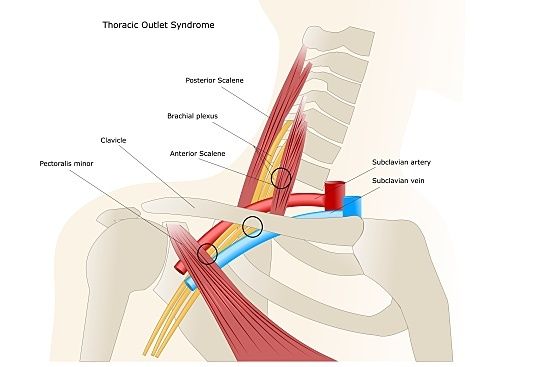Thoracic outlet syndrome is a fairly common phenomenon that can be caused by poor posture. Less than ideal posture is an unfortunate common sight in offices all over the world. People are absorbed and hunched over their computers while busy at work. Poor posture not only looks painful to the outside eye, it can also be a source of a lot pain problems, such as headaches, carpal tunnel syndrome, poor circulation, general muscle soreness and thoracic outlet problems.
What is thoracic outlet syndrome?
Mayo Clinic defines this syndrome as a group of disorders caused by pressure to the blood vessels and/or nerves located in the space between the first rib and collar bone (known as the thoracic outlet). All of the crucial nerves and blood flow that go from the neck into the arms pass through this outlet. Thus, it should be easy to imagine that damage to this area can wreak havoc. The most common affected tissues are the nerves, with up to 90% of cases being attributed to nerve damage. Common symptoms include general shoulder and neck tension, tingling in the hands and arms, muscle wasting, decreased hand grip strength, discoloration of the hands and arms (bluish usually) and poor pulse.

What causes it?
Thoracic outlet syndrome occur due to several different reasons. It can be caused by direct pressure from things like heavy backpacks or tight clothing. Other causes include pregnancy, trauma (like a car accident) or limited outlet space due to things like poor posture or varied human anatomy. While some of these causes are a quick fix, such as adjusting pressure to your shoulders. Posture may be easy to fix as well, with dedication to changing your daily habits. Some causes are harder to prevent to since no one plans for a car accident.
Differentiating from other nerve issues.
A lot of neck issues can also have very similar symptoms, such as cervical radiculopathy and carpal tunnel syndrome. Differentiating is the key to finding and managing the underlying cause. Circulation and nerve tissue health are important and need to be addressed adequately and quickly to promote optimal healing. Specific tests done to the thoracic outlet can help determine if this is the problem area and where to start with treatment. It is probably best to seek professional help from a Physical Therapist or Orthopedist. For an idea of what to expect with a visit you can check out this great resource here.
What can I do about it?
Oversight from a medical professional is advised with this specific condition since it potentially involves sensitive neural tissues that should be addressed as quickly as possible to minimize damage. (Once neural tissue is damaged it is slow to heal.) They will work with you on items likes correcting posture, hands on (manual) techniques to increase the amount of space available in the thoracic outlet, more in depth education in signs and symptoms to be aware of, and creating a home program that optimizes balance in the upper body with a personalized stretching and strengthening routine.
Basic self treatment.
If you are feeling confident or have seen and therapist and now want to try a few simple things on your own it is possible to try these simple strategies. The important thing is to seek medical help immediately if your symptoms get worse, especially tingling or muscle weakness. These are all great treatment options but are even better served if you exactly understand the underlying issue. No treatment (independently or guided) should make your symptoms worse so listen to your body and ask for help if needed.
- Optimize all home and office equipment. This includes optimizing set up for posture in your bed, car and at the office. Set yourself up for success so it is impossible to slouch. Being able to periodically change your position at work is a big bonus as well with something like a standing desk, to make poor posture less likely.
- Gentle Stretching. This can promote circulation to damaged nerves and relieve muscle tension. The idea is to gently stretch into the problem areas while being careful not to push too far and aggravate symptoms. Two great stretches to start with are side to side neck stretches and chest stretching against a wall or doorway (try holding for 60 seconds a time to start).
- Stress management. Stress can cause unnecessary tension and strain in the neck and shoulders. These tight muscles can contribute to a small thoracic space and pinch all those vital tissues. Practice stress management techniques such as deep breathing, daily exercise and adequate sleep.
- Trigger point massage. A very common muscle group that can cause thoracic outlet problems are the upper trapezius (one on each side of the shoulder and neck area). This is also a notorious area for muscle "knots." Just poking around in your neck you might have noticed areas that are tighter than others. Find these areas and apply deep direct pressure (with your hand, a tool, or the help of someone) that you can tolerate while staying relaxed (focus on deep breathing). Hold up to 2 minutes until the discomfort you have from the pressure subsides. Repeat as needed throughout this area to decrease muscle tension.
Thoracic outlet syndrome can cause scary symptoms that leave you wondering how you will get through the day in a functional manner. Knowing what to expect and how to proceed can be very helpful. Plus, just in case you needed another reason to motivate you to sit up straight, here it is!